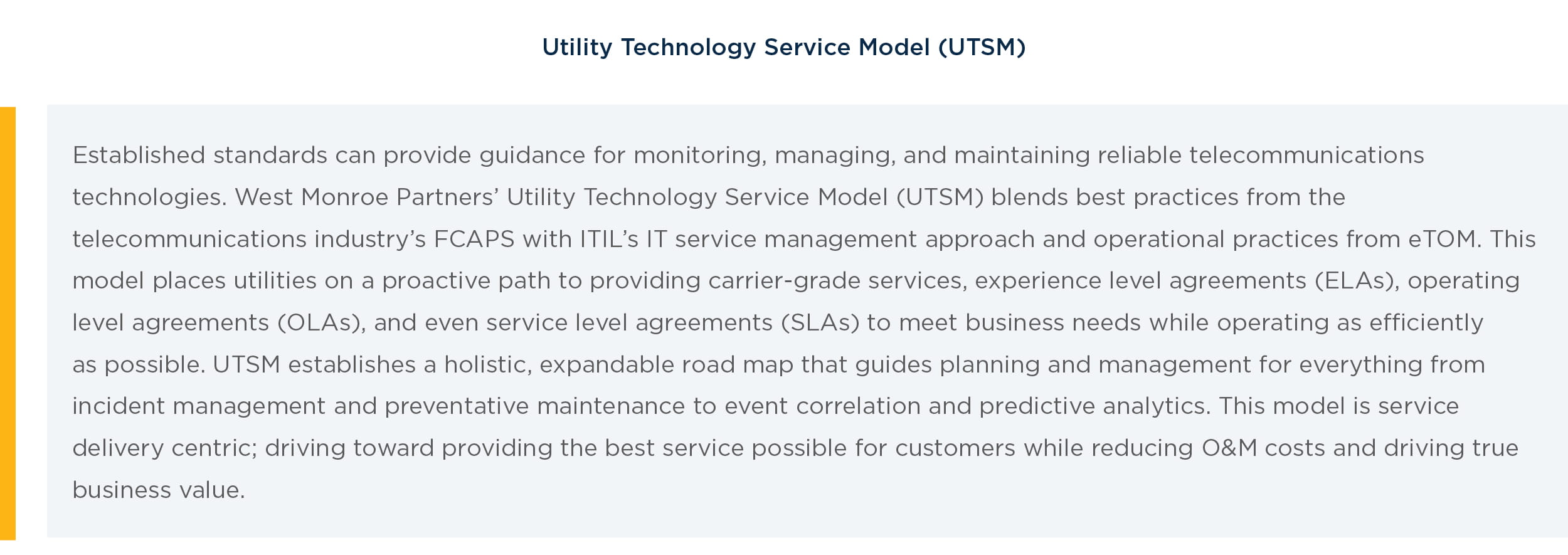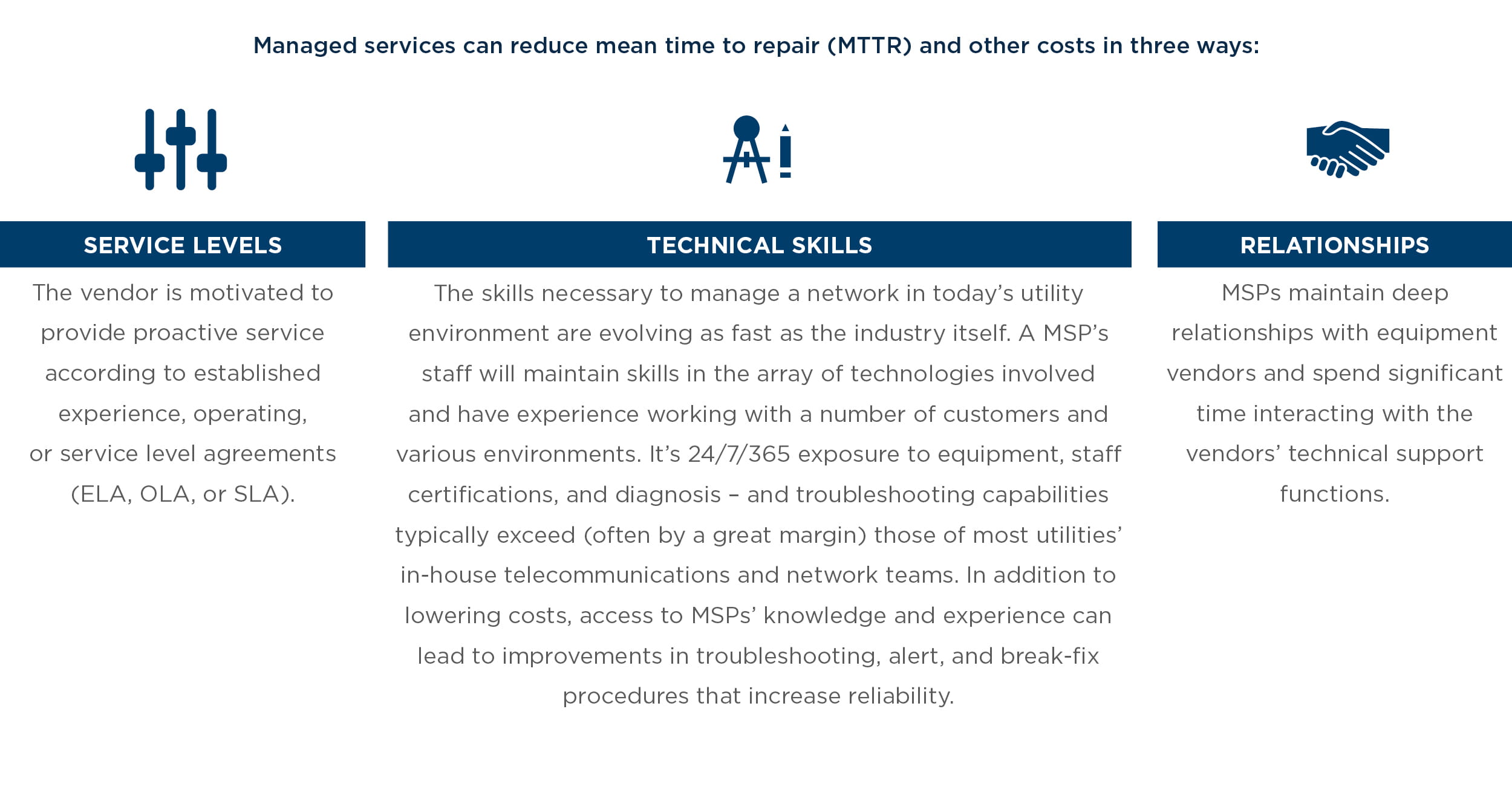
February 2017 | Point of View
Optimizing field area networks
Many loyalty reward strategies were built for the pre-digital marketplace — Now those loyalty and engagement efforts have become highly inefficient, hindering success.
Optimizing field area networks
Grid Modernization is driving a substantial increase in the number of smart devices in the field. Today, it’s not unusual that a utility has more deployed devices in its geography than a commercial wireless carrier. This significantly increases the complexity of its telecommunications network—and the complexity of managing that network.
As the foundation for your utility’s digital grid, your telecommunications network requires a new level of care and attention to make sure it supports reliable operations. This article outlines three steps that can help you set the course for maintaining a dynamic, reliable telecommunications network primed to help deliver the return you expect from smart-grid and modernization investments.
The connected revolution is spurring change at an unimaginable pace. It took less than a week for the brand new Pokémon Go app to surpass Facebook in terms of amount of time spent per day using the app. If that can happen, then you have to wonder what’s next!
While the utility telecommunications landscape doesn’t have a killer app driving change, that landscape nevertheless is evolving—and rapidly—due to connected utility devices and Internet of Things (IoT) technologies. A huge increase in the number of smart devices requires utilities to change business processes to take advantage of the information those devices produce. But utilities must also be prepared to ensure reliability of many remaining field devices that predate digital transformation.
Consider this. If you need directions to a destination but your smart phone’s battery is dead, what do you do? You could use a map— if you still keep one in your car. Most people, though, have long since ditched paper maps.
The same principle applies in utility telecommunications. Once you have automated switching, you may no longer have or need the “tools” (staff) to support “old ways” of working— like going out into the field and manually operating switches and other field equipment. With significantly more business-critical connected devices in the field today, your capacity to remotely manage, monitor, maintain, and control these devices is more critical than ever—but also more complex than ever. If you lack the capacity or capability to do so, grid reliability will suffer.
Build reliable service capabilities
As your utility transitions away from end- of-life carrier leased lines, your private telecommunications network becomes as fundamental to your business as a telecommunications network is for commercial wireless carriers. While you may not want or need to use your network for commercial purposes (to generate revenue), you will need to take many of the same steps a commercial carrier would take to design, deploy, and optimize network operations as budgets shrink and business demands increase.
Below are three steps that can help you deliver critical service levels and reliability—without requiring significant transformational effort.
1. Manage your telecommunications network like a commercial service provider manages its network.
As your modernization and smart grid initiatives advance, your utility’s business functions demand more information to help them reduce outage and losses, drive efficiency, decrease workload, streamline and optimize operations, or increase safety. This means more and more requests for connectivity for new applications in the field. The result is a network with potentially more devices in your geography than any individual commercial carrier has in its network! How will you manage that burgeoning network?
The banking, trading, and commercial telecommunications industries have developed proven capabilities for maintaining expansive, high-speed, secure, high-transaction networks– utilities have many of the same requirements, particularly reliability and resiliency. Moreover, utilities tend to have longer-term expectations for return on capital investments, and their total cost of ownership (TCO) projections focus on minimizing operational expenses. Those parameters add significant complexity to building and managing a utility field area network (FAN) that also meets evolving business requirements.
It will be important to create a holistic network vision with dynamic architecture. That vision and architecture should accommodate evolving requirements and rapid development of new applications and provide an efficient, cost-effective long-term operating model that enables your utility to remain competitive.
Utilities can learn from commercial telecommunications carriers, which have successfully created a service model mentality that is as robust as your “meter-to-cash” model is for your business today. For a commercial carrier, the telecom network is an optimized capital investment that meets demand, delivers strong and fast return on investment, and minimizes operational expenses to produce profits the business needs to be successful. Shifting your mindset to becoming a telecom provider to the utility business is a beneficial first step toward optimizing your network, organization, budget, and operations.
2. Develop efficient, effective, and well-documented operational processes.
You have thousands of deployed smart devices in the field, and you rely on them to provide the foundation for your digital grid. They are critical to your operations and instrumental to everything from Supervisory Control and Data Acquisition (SCADA) to distribution automation to substation security cameras. In fact, if your organization is like many utilities, you have “bet the business” on these devices and no longer have the staff to operate the “old fashioned” way.
Your service model and operational process should reflect this new environment. A good starting point is to understand the best practices of utilities across the country. Then, you can blend those with information technology (IT), operational technology (OT), and telecom industry standards—from simple network management in FCAPS to IT service management from ITI and TMForum’s eTOM for field device operations and monetization. Together, these practices and standards can help you create a service model with the best processes for successfully monitoring, managing, and maintaining—and perhaps even monetizing—your information and communications technologies networks. And by documenting and tracking operational processes, you gain insight that helps reduce operating and maintenance (O&M) costs while also increasing executive and internal customer satisfaction.
3. Take advantage of professional managed services, where appropriate
Each of the devices in your network requires telecommunications connectivity that enables real-time monitoring, control, and collection of diagnostic data. These complex devices also utilize a variety of different communication networks: fiber, lease line, 2-way radio, commercial cellular, private licensed and unlicensed microwave, mesh, point-to-point, and point-to-multipoint. Convergence of these networks and their data creates a significant utility integration challenge and requires data analytics to understand and maximize the benefits of all of the information now produced in the field.
Consider this scenario: An investor-owned utility in a large city is implementing advanced metering infrastructure (AMI) and distribution automation (DA) that spans three to four million meters. In addition, several thousand DA devices require reliable communication in order to automate switching operations and reduce outage and balance power delivery. That sounds simple, but it is actually quite complex. The advanced utility telecommunications network has more total devices than any of the local commercial wireless carriers. And while the utility has eliminated meter reading and millions of dollars in truck rolls, it now requires a world-class network management system, network operating center (NOC), and 24/7 technicians to monitor, manage, and maintain the network to meet service level expectations and maintain grid operations.
As your transformation progresses, your utility must be able to meet the additional challenges of monitoring and managing the network. Can you? Ask yourself:
- Is my telecommunications team large enough (or do you even have one)?
- How will I expand the team and what skillsets do they need?
- How will we operate and maintain this network?
- How will we provide the service level these business-critical devices require?
- How will we ensure the benefits can pay for enormous smart utility investments?
- To meet these challenges, some utilities are turning to managed network service providers (MSPs) that have adequate equipment, staff, and facilities to deliver these services, as well as many years of experience doing so. A MSP will equip its team with the tools and training necessary to meet specific service requirements, typically at a far lower cost—in our experience, often 10- 30 percent less—than owning and operating a telecommunications team and 24/7 NOC.
Tame the complexity – deliver the benefits your utility expects
Every organization today is challenged to do more with less. While utility modernization is cutting the need for resources in some areas, it is changing or even increasing the complexity of support required for others—one of those being the telecommunications network that provides the foundation for your utility’s digital grid.
Transformation will require you to continuously evaluate new network management capabilities. Continuous improvement is a must and you will need to acquire and maintain executive support, apply organizational change management, and facilitate adoption and training to ensure the processes, once developed and put in place, are continually supported and not “put on the shelf and forgotten," The three steps outlined in this paper can help set your utility on course to maintain a dynamic, reliable telecommunications network that enables your utility to derive the return on smart-grid and modernization investments it expects.




